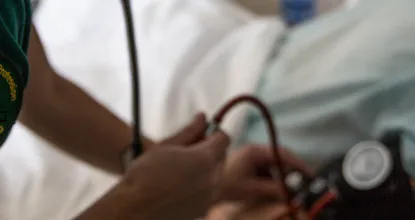What is Simulation?
As part of The School of Nursing’s dedication to educate students to be caring, competent and qualified to practice with diverse populations in constantly changing environments, Northern Michigan University provides students with Simulation experiences.
Simulation is an active learning strategy that engages students to practice simulated patient care in a safe environment posing no risk to real patients
It entails the replication of patient conditions using life-like patient simulator manikins. In nursing education, simulation represents real patient scenarios that are designed to enable students to practice combining theoretical knowledge with clinical skills within a controlled environment.
Why Use Simulation in Nursing Education?
The landmark Institute of Medicine (IOM) report, To Err is Human: Building a Safer Health System, recommends the use of simulation as a strategy to improve patient safety and quality of care.
Simulation is learner-centered:
- Enables students to practice in safe, non-threatening environment
- Enhances nursing skill performance
- Builds teamwork and effective communication
- Refines critical thinking
- Promotes clinical reasoning
- Reinforces clinical judgement and decision making skills
NMU School of Nursing Simulation Lab Mission
The NMU School of Nursing Simulation Lab will provide educational experiences that assist students in learning to provide safe and competent healthcare to diverse and ever changing populations.
Strategic Goals for the Simulation Lab
Education
- Cultivate a learning environment that is collegial, individualized and innovative.
- Provide experiential educational experiences that allow students to learn and practice critical thinking, skill attainment and communication with patients, families and the healthcare team.
- Increase awareness of patient safety in the healthcare environment.
- Incorporate best practices and standards of simulation across the curriculum.
Scholarship
- Encourage and support faculty and student research in the area of healthcare simulation.
- Evaluate simulation and educational strategies for effectiveness and student achievement of learning outcomes.
- Disseminate research findings to healthcare professionals at the local, regional and national level.
Outreach:
- Teach and foster interdisciplinary teamwork.
- Encourage and provide educational experiences in simulation to local and regional healthcare providers.
Simulation Labs
Northern Michigan University has multiple simulation labs that allow students to learn patient care in a safe, nonthreatening, controlled environment. NMU Simulation labs are simulated patient care settings that are equipped with realistic patient simulators, furnishings, and supplies that would be necessary to provide real patient care. This includes hospital beds, IV fluid/medication set-up, oxygen set-up, suction, and electronic medical records. Our patient simulators range from low fidelity to high fidelity which can be described as the level of realism. For example, some of the features of our high fidelity, or highly realistic, manikin Laerdal SimMan 3G™ include heart, lung, and bowel sounds, blinking, talking, sweating, IV access, chest rise and fall, and pulses.
Maternity Nursing Simulation Room
The OB Birthing Simulation Lab is located at 2612 F West Science.
This simulation lab room is dedicated to maternity nursing education.
You will find this lab room outfitted with the following:
- Birthing simulator model with newborn baby
- Birthing Bed
- Headwall System
- Simulated electronic medical records
Drake Family Pediatric Care Simulation Lab
This lab room is located at 2612 E West Science.
This pediatric simulation lab allows faculty to conduct advanced nursing care learning simulations. Students use a variety of standard and advanced care supplies and equipment specifically designed for delivering care to children.
In this lab you will find:
- One year old - Pediatric Hal
- Five year old - Pediatric Hal
- Six year old - SimJunior
- Pediatric Hospital Bed
- Headwall System
- Infant Intensive Care System Unit
- Broselow Emergency Cart
- Medication Cart
- Oxygen Cart
- Isolation Cart
- Simulated electronic medical records
Benda-Drake Critical Care Lab
This lab is located at 2612 B West Science.
This critical care simulation lab room emulates a stat-of-the-art ICU hospital room Faculty and students have a wide spectrum of high-end equipment, supplies and models to simulate advanced nursing care.
Some of the things you will find in this learning lab are:
- SimMan
- SimMan 3G
- Ventilator
- ICU headwall
- Wall-mounted physical assessment equipment
- ICU bed
- Hemodynamic monitor
- Nurses station
- Patient closet
- Isolation, crash and med carts
- Simulated electronic medical records
- Video debriefing capability
Simulation Staff

Julie Dobson, MPA, BSN, RN
Nursing Support/Simulation Specialist
- Assists faculty with simulation technology
- Attends national simulation conferences
- Orders specialized equipment and supplies
- Serves as the person responsible for maintenance and repair
- Coordinates with outside agencies and groups
History and Progression of NMU Simulation
NMU obtained its’ first patient simulator, SimMan™, in 2006. Around that same time, we were able to furnish and purchase simulation supplies from a generous donation from John and Cathi Drake which has enabled countless adult medical/surgical simulations. The Drakes decided to donate to NMU School of Nursing after an NMU nursing student, Naomi Benda, performed lifesaving CPR and emergency first aid on Cathi Drake at a restaurant.
In 2007 SimBaby™ was purchased for pediatric simulation and has been used for well-child and respiratory hospitalization care. A low fidelity birthing simulator, Noelle™ was purchased, proceeded by our high-fidelity Noelle™ in 2008. High-fidelity five-year-old Gaumard Hal™ was added to our Sim Family in 2010 and has been used for pediatric simulations including post-surgical care, emphasizing care and communication dynamics with a hospitalized child.
In 2012 our one-year-old Gaumard Hal™ was purchased and has been used for well-child and post musculoskeletal surgical traction simulations. Additionally, in 2012, SimMan 3G™ was purchased and is capable of portraying the most realistic patient with capabilities such as speaking, blinking, heart/lung sounds, and sweating, to name a few. SimMan 3G™ has been invaluable to student’s simulation experiences here at NMU though simulations such as cardiac arrest, trauma, and other medical surgical scenarios. Our latest additions include Vital Sim™ and Sim Jr™ purchased in 2015 and Victoria™ in 2016 who is the latest, most advanced high-fidelity obstetric and birthing simulator.
IN 2016-2017, the School of Nursing had a record of 1,567 student simulation experiences for the year. Our continued growth resulted in the need for increased space. In the summer of 2017, NMU administration, the College of Health Sciences and Professional Studies and the School of Nursing collaborated in designing a new space for simulation. Today, we proudly present our new six-room simulation lab located in 2612 West Science.
With a total of 10 patient simulators, trained staff, and realistic patient settings, Northern Michigan University is equipped to provide students with high quality active learning experiences to diverse populations in constantly changing environments.
References
1Billings, D. M., & Halstead, J. (2016). Teaching in nursing: A guide for faculty (5th ed.). St. Louis, MO: Elsevier.
2Bland, A. J., Topping, A., & Wood, B. (2011). A concept analysis of simulation as a learning strategy in the education of undergraduate nursing students. Nurse Education Today, 31(7), 664–670. https://doi.org/10.1016/j.nedt.2010.10.013
3Kohn, L. T., Corrigan, J., & Donaldson, M. S. (2000). To err is human: Building a safer health system. Washington, D.C: National Academy Press.
